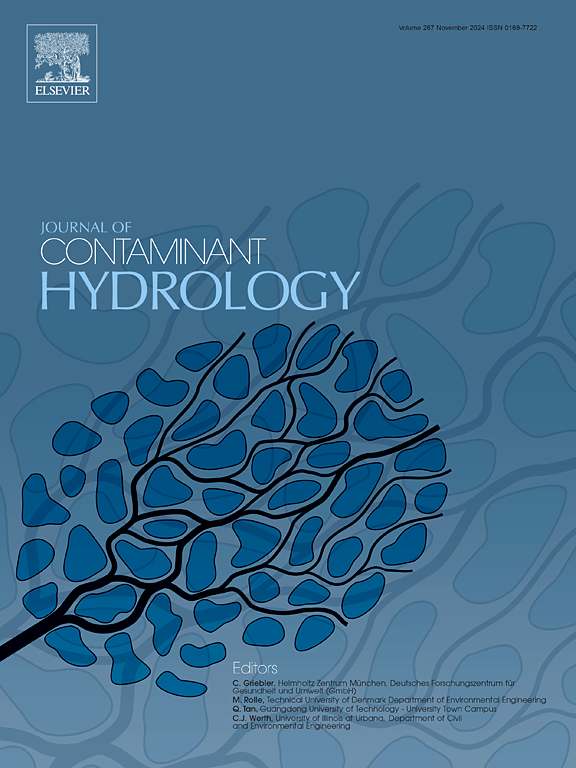实验室规模模拟含水层条件下的反硝化和同位素分馏效应
IF 4.4
3区 环境科学与生态学
Q2 ENVIRONMENTAL SCIENCES
引用次数: 0
摘要
反硝化作用在控制地下水中硝酸盐(NO3−)的去向中起着关键作用。反硝化过程中氮同位素富集因子(εN)是量化反硝化对地下水硝酸盐还原作用的重要指标。建立了含地下水和沉积物的实验柱来模拟含水层条件。在溶解氧(DO)浓度分别为1和2 mg·L−1的条件下,以乙醇、乙酸盐、葡萄糖和红糖为电子供体,采用实验柱测量了地下水和沉积物中NO3−的反硝化速率和N、O同位素分馏效应。上覆地下水(εNo和εOo)和沉积物孔隙水(εNp和εOp)的反硝化速率和稳定同位素富集因子随碳源和DO浓度的不同而发生显著变化。在DO =2 mg·L−1时,乙酸(εNo,−9.2‰,εNp,−7.4‰)、葡萄糖(εNo,−7.4‰,εNp,−4.3‰)、红糖(εNo,−2.6‰,εNp,−2.4‰)的负同位素富集因子小于乙醇(εNo,−11.7‰,εNp,−10.0‰)。对于红糖,当DO =1时(εNo,−5.0‰;εNp,−3.5‰),负同位素富集因子多于DO = 2 mg·L−1时。反硝化速率越高,εNo和εNp值越负,反映出氮分馏越强。由于o交换分数和NO3−还原过程,在反硝化柱上εOo和εOp值均为正,εOo值在5.0‰~ 29.2‰之间,εOp值在3.9‰~ 22.8‰之间。NO3−扩散输运导致εNo (εOo)绝对值高于εNp (εOp)绝对值。计算得到的同位素富集因子(εNo和εNp)可用于量化原位条件下碳源的反硝化作用。本文章由计算机程序翻译,如有差异,请以英文原文为准。

Denitrification and isotope fractionation effects under simulated aquifer conditions at a laboratory scale
Denitrification plays a critical role in controlling the fate of nitrate (NO3−) in groundwater. The nitrogen isotope enrichment factor (εN) during denitrification is essential for quantifying the role of denitrification in nitrate reduction in groundwater. Experimental columns containing groundwater and sediment were established to simulate aquifer conditions. Denitrification rates and the N and O isotope fractionation effects of NO3− in both groundwater and sediment during dentrification were measured in experimental columns using four organic substances as electron donors (ethanol, acetate, glucose and brown sugar) under two different dissolved oxygen (DO) concentrations of 1 and 2 mg·L−1, respectively. Significant variations in denitrification rates and stable isotope enrichment factors were observed in both overlying groundwater (εNo and εOo) and sediment pore water (εNp and εOp), depending on the carbon source and DO concentration. At DO =2 mg·L−1, acetate (εNo, −9.2 ‰; εNp, −7.4 ‰), glucose (εNo, −7.4 ‰; εNp, −4.3 ‰), brown sugar (εNo, −2.6 ‰; εNp, −2.4 ‰) exhibited less negative isotope enrichment factors compared to ethanol (εNo, −11.7 ‰; εNp, −10.0 ‰). For brown sugar, more negative isotope enrichment factors was observed at DO =1 (εNo, −5.0 ‰; εNp, −3.5 ‰) than at DO = 2 mg·L−1. Higher denitrification rates correlated with more negative εNo and εNp values, reflecting stronger nitrogen fractionation. Due to the O-exchange fraction and NO3− reduction processes, positive εOo and εOp values were observed in the denitrification columns, ranging from 5.0 ‰ to 29.2 ‰ for εOo and from 3.9 ‰ to 22.8 ‰ for εOp. Fractionation by diffusive transport of NO3− resulted in higher absolute values of εNo (εOo) compared to those of εNp (εOp). The calculated isotope enrichment factors (εNo and εNp) may be applied to quantify denitrification linked to C sources application under in situ conditions.
求助全文
通过发布文献求助,成功后即可免费获取论文全文。
去求助
来源期刊

Journal of contaminant hydrology
环境科学-地球科学综合
CiteScore
6.80
自引率
2.80%
发文量
129
审稿时长
68 days
期刊介绍:
The Journal of Contaminant Hydrology is an international journal publishing scientific articles pertaining to the contamination of subsurface water resources. Emphasis is placed on investigations of the physical, chemical, and biological processes influencing the behavior and fate of organic and inorganic contaminants in the unsaturated (vadose) and saturated (groundwater) zones, as well as at groundwater-surface water interfaces. The ecological impacts of contaminants transported both from and to aquifers are of interest. Articles on contamination of surface water only, without a link to groundwater, are out of the scope. Broad latitude is allowed in identifying contaminants of interest, and include legacy and emerging pollutants, nutrients, nanoparticles, pathogenic microorganisms (e.g., bacteria, viruses, protozoa), microplastics, and various constituents associated with energy production (e.g., methane, carbon dioxide, hydrogen sulfide).
The journal''s scope embraces a wide range of topics including: experimental investigations of contaminant sorption, diffusion, transformation, volatilization and transport in the surface and subsurface; characterization of soil and aquifer properties only as they influence contaminant behavior; development and testing of mathematical models of contaminant behaviour; innovative techniques for restoration of contaminated sites; development of new tools or techniques for monitoring the extent of soil and groundwater contamination; transformation of contaminants in the hyporheic zone; effects of contaminants traversing the hyporheic zone on surface water and groundwater ecosystems; subsurface carbon sequestration and/or turnover; and migration of fluids associated with energy production into groundwater.
 求助内容:
求助内容: 应助结果提醒方式:
应助结果提醒方式:


